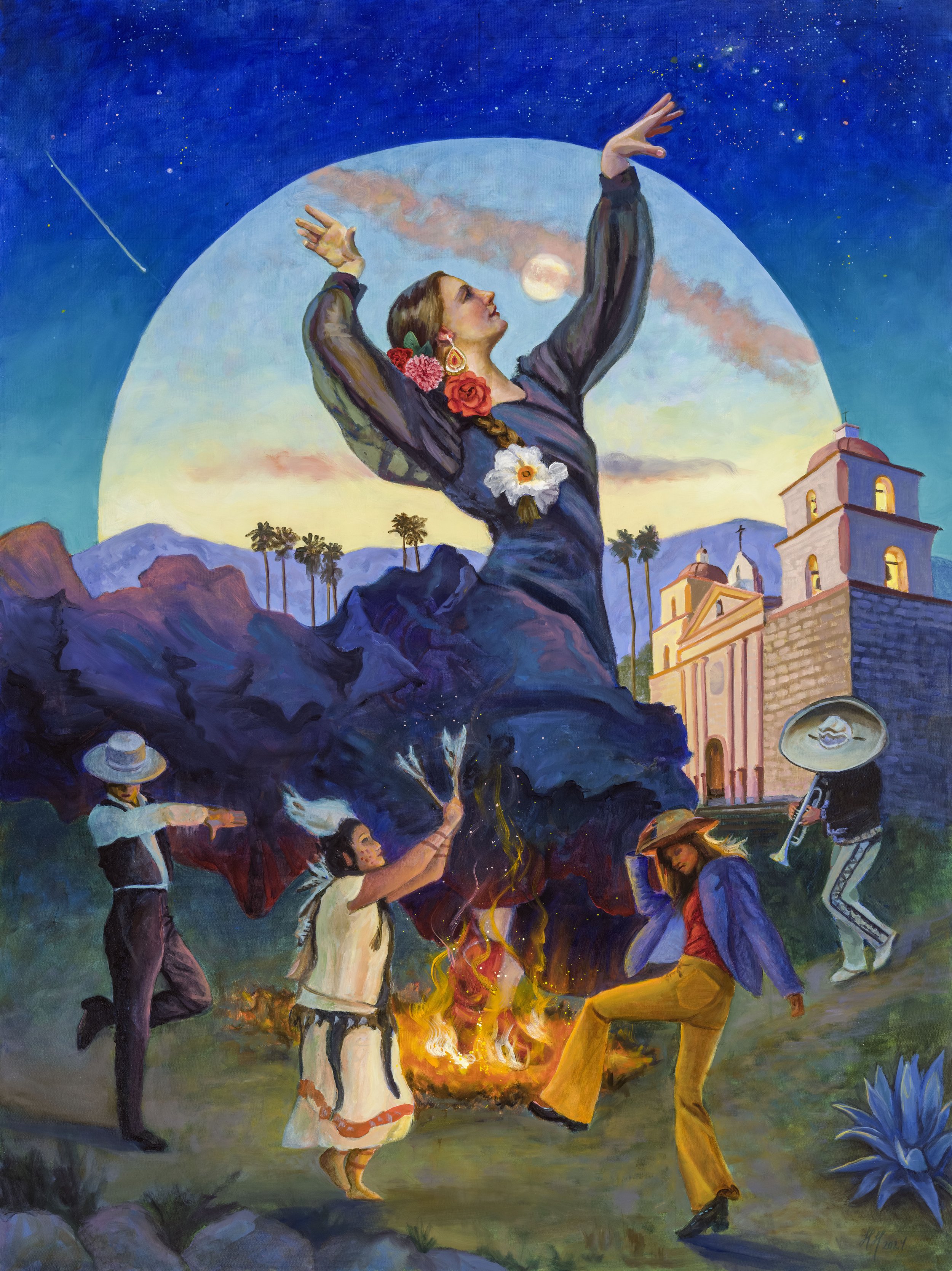
Four Nations, One Spirit
The painting for the Santa Barbara 2024 Centennial Fiesta Poster is titled Four Nations, One Spirit after El Presidente, Brian Schwabecher’s theme for the 100 year Anniversary of Fiesta in Santa Barbara. In this painting, I sought to capture the rich tapestry of cultures that have shaped California's history.
Each element was designed to illuminate the four cultures that create our Santa Barbara history. Fiesta is an event that was built around this history. This 5 day celebration started in 1924 by creating a parade and play about Santa Barbara’s history from 100 years prior (1824) and before. Since it’s inception, Fiesta has been a vibrant story of our community’s past, present and future.
The four nations that governed our city and county were the First Nation Chumash, followed by Spain (earliest colonizers), Mexico and currently the United States of America. Each of these cultures can be found in our modern day community.

Four Nations, One Spirit
Painting Style and Symbolism
Most of our history as we know it is based in some fact, but often embellished, told from one perspective and romanticized. The traditional painting style reflects how we like to remember ourselves and romantically recreate our memoir. Part of Fiesta’s allure is we get to dress up and remember the “good old days”. However, the strength of Fiesta is, we come together joyously to celebrate our shared heritage, bring our community together, and annually celebrate who we are.
The Spirit of Fiesta
The Spirit of Fiesta is large and central in the composition. Her form mirrors goddesses from art history.
She dances her way out of the light and fire. Historically, fire has illuminated each of the Nations that governed this area. In each of these cultures our forebears would have gathered around a fire for warmth and light in all their celebrations. The spirit of Fiesta is born from this light from our collective past and but can reach for the stars into the future.
In her hair, 4 flowers represent each nation. Farthest and smallest is the carnation, representing Spain, followed by a Dahlia representing Mexico. These sit next to her ear. Farther down her braid is the red Rose, representing America, and at the end of her braid is the Matilija poppy, representing the Chumash Nation, which was the beginning of the historical legacy.

In the Background
The lighting is intentionally liminal as Fiesta is a celebration that carries throughout the day and into the night. The Santa Ynez Mountain range anchors the background with a full moon rising. This lunar element is a reminder that the earliest Fiesta’s were organized around the full moon in August. Palm trees line the horizon as placeholders for Santa Barbara’s well know skyline. The Queen of the California Missions also is a historical symbol that tells the story of Spanish colonization. The Santa Barbara Mission is well know for its beauty.
The night sky holds reference to the past and future. Ernestine De Soto is our Babareno Elder in the Santa Barbara Chumash community. She translated a Chumash fable called The Sugar Bear which was told to her by her Chumash mother. I have used the “Big Dipper” or Ursa Major to represent our Chumash ancestors. This is flying off of the Spirit of Fiesta’s hand on the right. The rocket launch streaking across the night sky on the left keeps us in the present. Rocket launches out of Vandenburg can be seen and heard in our town. This rockets represents our present and future..

In the Foreground
The four Nations dance at the feet of the Spirit of Fiesta. Both the native Chumash and American dancers are women. The are the front and center of the foreground serving as book ends for the earliest governing nation and present governing nation. They are both purposely female. In our current era, our histories and present day documentation have a stronger female perspective and voice. The Chumash dancer is in traditional regalia ( Kathleen Marshall of the Santa Ynez Chumash band) and the American dancer is a contemporary “boho cowgirl”, which is currently in fashion.
Leading into the foreground are two male figures. On the left is a Spanish Flamenco dancer and on the right is a Mexican Mariachi trumpet player. Both of these cultures are central to Southern California style, communities, and architecture.
The Agave Americana or Century plant was included to mark the centennial.